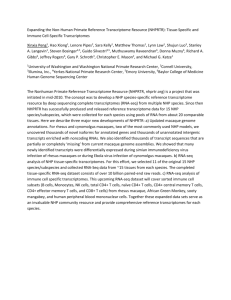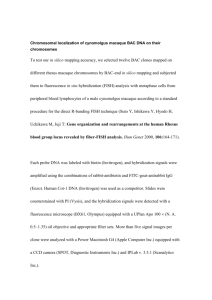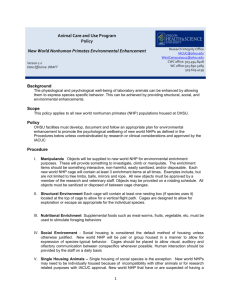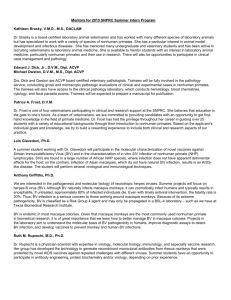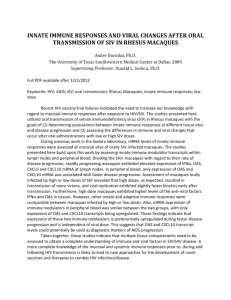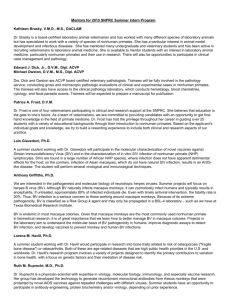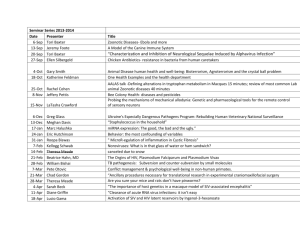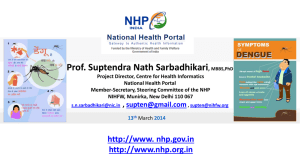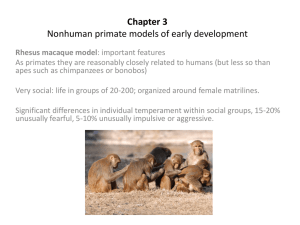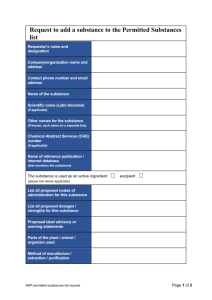Number 2 - Laboratory Animal Boards Study Group
advertisement
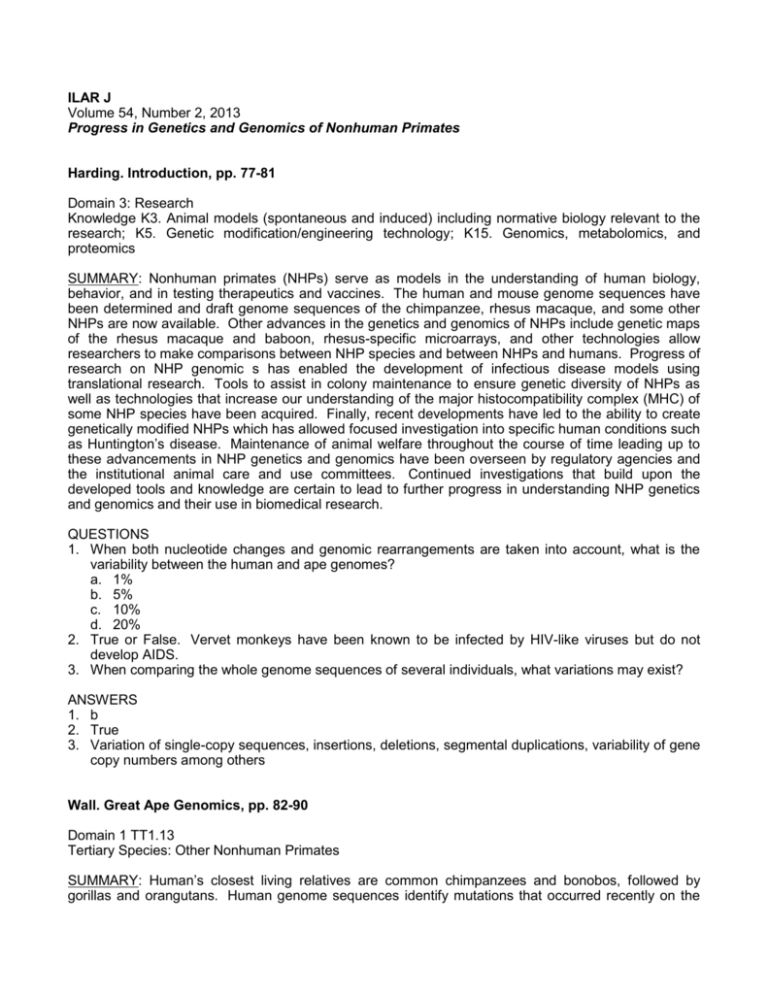
ILAR J Volume 54, Number 2, 2013 Progress in Genetics and Genomics of Nonhuman Primates Harding. Introduction, pp. 77-81 Domain 3: Research Knowledge K3. Animal models (spontaneous and induced) including normative biology relevant to the research; K5. Genetic modification/engineering technology; K15. Genomics, metabolomics, and proteomics SUMMARY: Nonhuman primates (NHPs) serve as models in the understanding of human biology, behavior, and in testing therapeutics and vaccines. The human and mouse genome sequences have been determined and draft genome sequences of the chimpanzee, rhesus macaque, and some other NHPs are now available. Other advances in the genetics and genomics of NHPs include genetic maps of the rhesus macaque and baboon, rhesus-specific microarrays, and other technologies allow researchers to make comparisons between NHP species and between NHPs and humans. Progress of research on NHP genomic s has enabled the development of infectious disease models using translational research. Tools to assist in colony maintenance to ensure genetic diversity of NHPs as well as technologies that increase our understanding of the major histocompatibility complex (MHC) of some NHP species have been acquired. Finally, recent developments have led to the ability to create genetically modified NHPs which has allowed focused investigation into specific human conditions such as Huntington’s disease. Maintenance of animal welfare throughout the course of time leading up to these advancements in NHP genetics and genomics have been overseen by regulatory agencies and the institutional animal care and use committees. Continued investigations that build upon the developed tools and knowledge are certain to lead to further progress in understanding NHP genetics and genomics and their use in biomedical research. QUESTIONS 1. When both nucleotide changes and genomic rearrangements are taken into account, what is the variability between the human and ape genomes? a. 1% b. 5% c. 10% d. 20% 2. True or False. Vervet monkeys have been known to be infected by HIV-like viruses but do not develop AIDS. 3. When comparing the whole genome sequences of several individuals, what variations may exist? ANSWERS 1. b 2. True 3. Variation of single-copy sequences, insertions, deletions, segmental duplications, variability of gene copy numbers among others Wall. Great Ape Genomics, pp. 82-90 Domain 1 TT1.13 Tertiary Species: Other Nonhuman Primates SUMMARY: Human’s closest living relatives are common chimpanzees and bonobos, followed by gorillas and orangutans. Human genome sequences identify mutations that occurred recently on the human branch. It has been shown that FOXP2 gene has one non-synonymous mutation separating chimpanzee and mouse sequences and human have two non-synonymous mutations. FOXP2 has been shown to control spoken language capacity. Researchers have identified functional gene categories showing evidence for positive selection. It was found that certain functional categories were overrepresented amount genes inferred to be recently selected for. It is possible that most of the 2% human genome differing from great apes involve regulatory sequences. Studies have shown that regulation of majority of genes evolve under evolutionary constraint and stabilizing selection. Gene loss rate of human lineage is comparable to loss rate in other great ape lineages. Humans have diploid chromosome number 2n=46 while great apes have 2n=48. Human chromosome 2 is evidenced to be formed by fusion of 2 autosomes. Amount of divergence between 2 sequences is proportional to time since they last shared common ancestor. Two randomly chosen human chromosomes differ at 1 in a 1000 base pairs, suggesting smaller population size. This suggests that in human history population size was much smaller and very recently grew larger. The opposite is seen in the great apes, leading to believe that there were more chimpanzees, gorillas, and orangutans around than humans prior to 50.000 years ago. For every 4 autosomes there are 3 X chromosomes with higher diversity in X versus autosome comparisons. Recombination events occur in narrow 1-2 kilobase “hot spots” and humans and chimpanzees generally do not share “hot spots.” Direct relevance to human health and great ape genomics involves zoonosis. HIV-1 is similar to SIV cpz, a simian immunodeficiency virus found in chimpanzees. Chimpanzees are natural reservoir of HIV-1 with transmission events of HIV from chimps to humans. Studying great ape demography helps with promoting conservation, health and genetic diversity. DNA-based studies identify populations that are distinct from others helping to elevate importance of preserving them. Study of mtDNA from orangutan helped recognize Sumatran orangutan as separate species. Also, a fourth chimpanzee subspecies was argued for during a study of autosomal SNP variation. Genetic studies estimate extent of population decline in chimpanzees and orangutans, as well as genetic homozygous tracts in bonobos show concern for inbreeding due to small population size. QUESTIONS 1. The FOXP2 gene has been found to control what? a. Spoken language capacity b. Written language capacity c. Short term memory capacity d. Long term memory capacity 2. Humans have 2n=___ chromosome number while chimpanzees have 2n=___ chromosome number a. Humans = 48, chimps = 46 b. Humans = 46, chimps = 48 c. Humans = 52, chimps = 48 d. Humans = 46, chimps = 42 3. HIV-1 is similar to what simian immunodeficiency virus found in chimpanzees? a. SIV-1 b. HIV-1 c. SIV cpz d. SIV mnd ANSWERS 1. a. Spoken language capacity 2. b. Humans = 46, chimps = 48 3. c. SIV cpz Vinson et al. The Value of Extended Pedigrees for Next-Generation Analysis of Complex Disease in the Rhesus Macaque, pp. 91-105 Primary Species: Macaques (Macaca spp.) Domain 3. T3. K3 and K6 SUMMARY: Complex diseases (e.g., cardiovascular disease and type 2 diabetes, among many others) pose the biggest threat to human health worldwide and are among the most challenging to investigate. Susceptibility to complex disease may be caused by multiple genetic variants (GVs) and their interaction, by environmental factors, and by interaction between GVs and environment, and large study cohorts with substantial analytical power are typically required to elucidate these individual contributions. Here, we discuss the advantages of both power and feasibility afforded by the use of extended pedigrees of rhesus macaques (Macaca mulatta) for genetic studies of complex human disease based on next-generation sequence data. We present these advantages in the context of previous research conducted in rhesus macaques for several representative complex diseases. We also describe a single, multigeneration pedigree of Indian-origin rhesus macaques and a sample biobank we have developed for genetic analysis of complex disease, including power of this pedigree to detect causal GVs using either genetic linkage or association methods in a variance decomposition approach. Finally, we summarize findings of significant heritability for a number of quantitative traits that demonstrate that genetic contributions to risk factors for complex disease can be detected and measured in this pedigree. We conclude that the development and application of an extended pedigree to analysis of complex disease traits in the rhesus macaque have shown promising early success and that genome-wide genetic and higher order -omics studies in this pedigree are likely to yield useful insights into the architecture of complex human disease. QUESTIONS: 1. What are some advantages of the Rhesus Macaque model for genetic discovery in complex human disease? a. Very close genetic similarity to humans b. Similar physiology to humans c. Share high percentage of human genes d. All of the above 2. What is a SNP? a. Single nucleotide polymorphism b. Similar nonpathology c. Somatic nuclear phage 3. What is a type 1 error? a. Occurs when the null hypothesis is accepted when in fact it is false b. Occurs when the null hypothesis is rejected erroneously when it is in fact true c. Occurs when the null hypothesis is accepted when it is true d. None of the above 4. The chi-square statistic: a. Is used to measure the agreement between categorical data and multinomal model that predicts the relative frequency of outcomes in each possible category. b. Summarizes the discrepancies between the expected number of times each outcome occurs (assuming that the model is true) and the observed number of times each outcome occurs, by summing the squares of the discrepancies, normalized by the expected numbers, over all the categories. c. As the sample size n increases, if the model is correct, the sampling distribution of the chisquared statistic is approximated increasingly well by the chi-squared curve with (#categories − 1) = k – 1 degrees of freedom (d.f.), in the sense that the chance that the chi-squared statistic is in any given range grows closer and closer to the area under the Chi-Squared curve over the same range. d. All of the above. ANSWERS: 1. d. All of the above 2. a. Single nucleotide polymorphism 3. b. Occurs when the null hypothesis is rejected erroneously when it is in fact true 4. d. All of the above. Cox et al. Baboons as a Model to Study Genetics and Epigenetics of Human Disease, pp. 106121 Domain 3: Research Secondary Species: Baboon (Papio spp.) SUMMARY: Baboons share many genetics, biochemical, and anatomical characteristics to man. In addition, the availability of genetic and genomic resources, including a large pedigreed population, makes them a particularly valuable model. Genetic and Physiologic Similarities: Important physiological similarities shared with humans include year-round ovulatory cycles, reproductive senescence (menopause), bones undergo remodeling in adulthood, heart size and function, and similar lipid and carbohydrate metabolism. The two species also have similar overall DNA sequence identity and gene sequence arrangement which facilitate research on the genetic factors involved with disease. Genetic and Genomic Resources: The Southwest National Primate Research Center maintains a colony of extensively pedigreed baboons and banked DNA, blood, and tissue samples. The breeding colony is managed such that a high number of individuals with specific useful relationships exist, for example siblings or half siblings. There is a baboon genome assembly that is under development. Genetics of Cardiovascular Disease: “The baboon has served as the preeminent nonhuman primate model for cardiovascular disease (CVD) genetics studies since the observation that baboons fed a high-cholesterol diet developed arterial lesions.” Genes influencing LDL cholesterol size fractions, response to dietary LDL cholesterol, and activity of lipoprotein-associated phospholipase A2 have been located via linkage mapping. Other studies have looked at inflammatory component of athrogenesis by analyzing expression data in leukocytes. Genetics of Obesity: Certain obesity-related traits have been found to have a significant heritable component in baboons including body weight, fat mass, waist circumference, adipocyte cell volume, leptin concentration, and insulin resistance phenotypes. Linkage mapping has identified a number of genes that may be involved in these heritable traits such as cholecystokinin and ghrelin. Linkage mapping has also helped explore the role of adiponectin and adipokines in heritable obesity related traits. Genetics of Hypertension: Rats are the most commonly used animal model to study hypertension; however there are certain genetic mechanisms of blood pressure regulation that are unique to primates. For example, sodium-lithium counter transport activity is a heritable trait for salt-sensitive hypertension in primates but not in other mammals. In comparing hypertensive and normotensive baboons, MHC I, II, and III renal gene expression was up regulated in hypertensive animals. The Baboon in Age-Related Skeletal Disease Research: Baboons experience post-menopausal bone loss and are a good model to explore genes and bone biomechanical properties that affect features of osteoporosis. In addition, older baboons have reasonably similar rates of idiopathic knee osteoarthritis as humans providing an important opportunity to assess genes that influence osteoarthritis development. Epigenetics and Genetics of IUGR: Intrauterine growth restriction in humans can be a result of poor nutrition, teenage pregnancy, and in pregnancies involving placental disease, preeclampsia, or maternal vascular disease. Using nutrient restriction to induce IUGR researchers have been able to demonstrate several markers that are characteristic of IUGR, including elevated fetal cortisol Gene expression and Epigenetic Studies in IUGR: Differences in gene expression and global methylation have been documented between fetuses of nutrient restricted mothers and controls. Postnatal Studies on Offspring of Mothers Experiencing Global Maternal Nutrient Restriction: Three and a half year old offspring of nutrient restricted mothers showed changes in insulin resistance and adverse neurobehavioral outcomes (impaired learning and increased impulsivity). New Studies and Resource Development Epigenetics and Response to Diet: MicroRNAs: miRNAs are “endogenous, small noncoding RNAs (approximately 22 nts) that post-transcriptionally regulate gene expression through mRNA degradation or translational silencing.” In studies using baboons 7 miRNAs were found that may regulate LDL cholesterol concentration variation in response to a high-cholesterol diet. Epigenetics of Response to Diet: DNA methylation and the transcriptome: A pilot study comparing metabolic and molecular response to a high fat and high sugar diet in baboons has provided evidence of some of the expression changes seen are regulated by promoter CpG methylation and/or miRNA targeting. Development of New Baboon Genomic and Transcriptomic Resources: There are continuing efforts to improve and refine the baboon whole genome map by identifying additional polymorphic genomic markers. How the Research Community Can Access Baboons, Baboon Genetic and Genomic Resources, and Sources of Expertise for Studies Using Baboons: Information on accessing banked biological samples, genetic information, and specific research area focused resources is included in this section. QUESTIONS 1. True or false: Female baboons only ovulate in the spring and summer 2. Sodium-lithium counter transport activity is heritable for which of the following: a. Baboons b. Humans c. Rats d. Only a and b 3. True or false: Osteoarthritis is an inevitable consequence of aging and virtually all older baboons show articular cartilage damage degradation in the distal femur. 4. _______ are endogenous, small noncoding RNAs (approximately 22 nts) that post-transcriptionally regulate gene expression through mRNA degradation or translational silencing a. rRNA b. mRNA c. miRNA d. None of the above ANSWERS 1. False-ovulate year-round 2. d. SLC activity is heritable in primates only 3. False- approximately 1/3 of aged baboons have healthy articular cartilage, similar to the percent is seen in geriatric humans 4. c Jasinska et al. 2013. Systems Biology of the Vervet Monkey, pp. 122-143 Domain 3: Research Tertiary Species: Other Nonhuman Primates SUMMARY: This article describes the phylogeny and population history of the vervet monkey and summarizes the use of both captive and wild vervet monkeys in biomedical research. The vervet monkey (also called the African green monkey) is particularly widely employed for investigations of brain and behavior, metabolism, and immunity. Vervets are the most abundant natural host of simian immunodeficiency virus (SIV). Like other African natural hosts of SIV, when infected with their species-specific SIV, vervets typically do not progress to immunodeficiency (Hahn et al. 2000; Pandrea and Apetrei 2010; Pandrea et al. 2008; Pandrea et al. 2009). Caribbean vervets are free of SIV. Ma et al. (2013) recently identified an additional protective process against SIV infection in wild African vervet populations—resistance to acquiring SIV infection. This article describes the steps that this researcher and other members of an international collaborative effort have taken to develop this species into a comprehensive NHP model for systems biology. These steps include comprehensive phenotypic, genetic, and genomic characterization of large study samples of pedigreed vervets assessed in research colonies as well as independent vervets assayed in wild populations. The sequencing of the mitochondrial cytochrome b gene in more than 100 monkeys from Africa and the Caribbean has provided initial insight into the genetic diversity of Chlorocebus (Haus et al. 2013). They identified nine major clades, which reflect geographic distributions rather than taxa, and also confirmed hybridization between subspecies in contact zones. Caribbean vervets, as they age, naturally develop cerebral amyloid beta plaques; these are associated with gliosis and neuritic dystrophy, making the vervet a model for Alzheimer’s disease research and treatment (Lemere et al. 2004). Comparison of genetic markers order between vervet and other primate chromosomes revealed 12 rearrangements compared with human, 16 compared with chimpanzee, and 12 compared with rhesus macaque. Nine human chromosomes showed full colinearity with vervet, 10 contained one or two simple marker rearrangements, and one (human chromosome 3) showed a more complex rearrangement (Jasinska et al. 2007). NHP models provide an opportunity to assess gene expression in tissues (such as brain) from which high-quality RNA is often unavailable in humans. A vervet tissue gene expression atlas was constructed by measuring expression from a subset of 24 brain regions from 3 male vervets and 3 female vervets from the VRC and by conducting basic comparisons of gene expression between different brain regions, which can be accessed through the Integrated Vervet/AGM Research and Resources website. Compared with apes and humans, OWMs show considerably less crossspecies variability in the macroscopic and cytoarchitectonic anatomy of the brain. Live trapping is the most efficient way of collecting biological samples, phenotype data, and health data from wild vervets (Brett et al. 1982). Vervets typically live in multimale, multifemale cohesive social groups ranging in size from 5 to more than 75 individuals (Isbell et al. 1991; Turner et al. 1997) and aggressively defend group territories that range in size from 0.6 km2 to 1.78 km2 (Harrison 1983; Kavanagh 1981). Females are philopatric, typically remaining in their natal groups for life, whereas males typically disperse around sexual maturity (Cheney and Seyfarth 1983). The vervet, in comparison with other OWM models, more closely resembles human beings in lipoprotein metabolism and in the distribution and characteristics of atherosclerotic lesions that develop in response to a Western diet (Bullock et al. 1975, Fusegawa et al. 2001; Rudel et al. 1981). Vervets also have proven useful in modeling the development of metabolic disorder, including obesity-related insulin resistance and type 2 diabetes (Kavanagh et al. 2007; Clarkson et al. 1985). Monoamine metabolites are important regulators of primate behavior and show links to common human neuropsychiatric phenotypes, but genetic regulation of their metabolism, which may underline these traits, is poorly known. QUESTIONS 1. Wild Caribbean vervet populations of Chlorocebus____?____ from St. Kitts, Nevis, and Barbados are perhaps the largest source of vervets for biomedical research. Monkeys captured from these populations, as well as their colony-born descendants, are housed primarily at the following colonies, all of which make monkeys available to the scientific community more broadly: the VRC, now located at Wake Forest University in North Carolina, the main breeding colony in the United States; the New Iberia Research Center, in Louisiana; the St. Kitts Biomedical Research Foundation; the Behavioral Science Foundation, also on St. Kitts; and the Barbados Primate Research Center. a. Cynosuros b. Sabaeus c. Aethiops d. Pygerythrus 2. Chlorocebus _____?_____is the second most commonly used vervet subspecies in biomedical research. The US-based vervet colony located in the National Institutes of Health Animal Center was established from monkeys of this subspecies captured from Tanzania. a. Tantalus b. Sabaeus c. Pygerythrus d. Djamdjamensis 3. In vervets, the diploid chromosome number is 2N = ___ ? a. 36 b. 48 c. 56 d. 60 4. Which are natural hosts for SIV? a. Cercocebus atys, Chlorocebus aethiops, & Mandrillus sphinx b. Pan troglodytes, Chlorocebus aethiops, & Macaca mulatta c. Cercocebus atys, Macaca mulatta, & Mandrillus sphinx d. Mandrillus sphinx, Cercocebus atys, & Pan troglodytes ANSWERS 1. b 2. c 3. d 4. a Norgren. Improving Genome Assemblies and Annotations for Nonhuman Primates, pp. 144-153 Domain 3: Research SUMMARY: Nonhuman primate (NHP) studies are important for understanding human evolution and as biomedical research models. Currently available NHP genomes contain many mistakes and are thus misleading to investigators and are of insufficient quality to serve as references for NextGen studies. Greater investments in both time and money could greatly improve assemblies and annotations of NHP genomes, which could transform NHP research. QUESTIONS 1. Which of the following is the genus and species of common marmosets? a. Microcebus murinus b. Daubentonia madagascariensis c. Callithrix jacchus d. Cercocebus atys 2. Which of the following is the genus and species of olive baboons? a. Papio anubis b. Pongo abelii c. Pan troglodytes d. Macaca fascicularis 3. Which of the following is the genus and species of mouse lemurs? a. Gorilla gorilla b. Microcebus murinus c. Callithrix jacchus d. Pan paniscus 4. Which of the following is the genus and species of rhesus macaques? a. Macaca fascicularis b. Nomascus leucogenys c. Macaca mulatta d. Macaca nemestrina 5. Which of the following is the genus and species of cynomolgus macaques? a. Macaca fascicularis b. Nomascus leucogenys c. Macaca mulatta d. Macaca nemestrina 6. Which of the following is the genus and species of pigtail macaques? a. Macaca fascicularis b. Nomascus leucogenys c. Macaca mulatta d. Macaca nemestrina 7. Which of the following is the genus and species of African green monkeys? a. Macaca mulatta b. Pan troglodytes c. Chlorocebus aethiops d. Cercocebus atys 8. Which of the following is the genus and species of sooty mangabeys? a. Macaca mulatta b. Pan troglodytes c. Chlorocebus aethiops d. Cercocebus atys 9. Which of the following is the genus and species of chimpanzees? a. Pan paniscus b. Pan troglodytes c. Gorilla gorilla d. Pongo abelii 10. Which of the following is the genus and species of bonobos? a. Pan paniscus b. Pan troglodytes c. Gorilla gorilla d. Pongo abelii 11. Which of the following is the genus and species of white-cheeked gibbons? a. Nomascus leucogenys b. Propithecus coquerelli c. Daubentonia madagascariensis d. Papio anubis 12. Which of the following are of interest to AIDS investigators because of their natural resistance to HIV? a. Sooty mangabeys and rhesus macaques b. African green monkeys and rhesus macaques c. Sooty mangabeys and African green monkeys d. Cynomolgus macaques and rhesus macaques ANSWERS: 1. c 2. a 3. b 4. c 5. a 6. d 7. c 8. d 9. b 10. a 11. a 12. c Vallender and Miller. Primate Models in the Genomic Era: A Paradigm Shift, pp. 154-165 Domain 3: Research SUMMARY: Model organisms are valuable because they can be controlled and manipulated in ways that humans cannot. Nonhuman primates (NHPs) have not largely seen control on this level though. Difficulties in animal procurement, coupled with increased ethical considerations and concomitantly higher husbandry costs, lead to necessarily small sample sizes. Because of this, a greater understanding of NHP genetics is required. The evolutionary association between host and pathogen is a close one, and the mutations associated with susceptibility or control vary greatly between even closely related taxa. Although the examples of infectious diseases that can be studied only in NHPs are numerous, the most notable examples are human hepatitis C virus (HCV) and human immunodeficiency virus (HIV). In addition, NHPs show neuroanatomic and behavioral similarities to humans that other species do not. Though this alone does not imply translational validity, it improves the chance of success. Owing to a relatively recent population bottleneck, human genetic variation is less than what is observed in many species, including those that dominate NHP models. There are very few transspecies polymorphisms in humans and chimps; those identified are associated with immune responsemost notably, the major histocompatibility complex (MHC; also known as human leukocyte antigen). Where polymorphism is known to affect phenotypes, taking this into account can significantly improve study design and can give much greater statistical power to the variables that are being tested. Early on, species differences in response to HIV were recognized, leading to the development of the macaque model, but it was not long before scientists also noticed a differential response in rhesus macaques of different geographical origin; Indian-origin rhesus macaques respond more similarly to humans than their Chinese-origin brethren. This followed the recognition that Indian-origin rhesus with certain alleles at the MHC locus, notably A*01, B*08, and B*17 were more resistant to SIV infection. It is essential that in both control groups and experimental groups natural genetic variation, which affects the same dependent variables, is taken into account a priori. In humans, genetic variation at the P450s (cytochrome P450 proteins; CYPs), is associated with differential drug metabolism, efficacy, and toxicity. By expanding understanding of polymorphism in NHPs at the CYPs, we both develop better models of human pharmacogenetics associated with drug metabolism and ensure that ongoing studies of drug safety and risk are fully informed and not influenced by false findings resulting from cryptic genetic variability. The genomic revolution has reverberations beyond the macaque. As more and more species are better genetically characterized, their suitability for specific kinds of biomedical research can be better appreciated. Just as understanding of the MHC has led to directed selection of animals for SIV studies, this greater understanding of functional genetic variation will help dictate how animals can best be used across all studies. QUESTIONS 1. The acronym MHC stands for which one of the following with respect to the use of rhesus macaques in SIV research? a. Myosin Heavy Chain b. Major Histocompatibility Complex c. Minor Histocompatibility Complex d. Major Human Compatibility 2. Which of the following respond more similarly to humans in terms of SIV infection? a. Baboons b. Chimpanzees c. Chinese-origin rhesus macaques d. Indian-origin rhesus macaques ANSWERS 1. b. Major Histocompatibility Complex 2. d. Indian-origin rhesus macaques Palermo et al. Old World Monkeys and New Age Science: The Evolution of Nonhuman Primate Systems Virology, pp. 166-180 Domain 3: Research; T3. Design and conduct research Primary Species: Macaques (Macaca spp.) Tertiary Species: Other Nonhuman Primates SUMMARY AND KEY POINTS: With nonhuman primate models of human health and disease remaining as a critical part of biomedical research, the dawn and continued growth of molecular genetics and systems biology has included the use of primate genomic research to better understand the molecular basis of NHP model disease phenotypes. This paper uses examples of the use of genomics in studies of simian immunodeficiency virus and respiratory virus infection pathogenesis, plus related processes for vaccine development. Among the steps in use of genomics to characterize NHP models are: 2000 - First nonhuman primate genomics workshop 2001 - Beginning of work to generate expressed sequence tag (EST) databases for macaque species 2003 - Initiation of rhesus macaque (Macaca mulatta) genomic sequencing. 2007 - Publications using rhesus gene expression microarray, including work with macaque SIV infection , and influenza infection. These differentiated the infection pathogenesis for different macaque species, age groups and different virus strains (e.g. - influenza H5N1, 1918 pandemic influenza virus) 2012 - first release of data from the NHP Reference Transcriptome Resource (NHPRTR) Other studies followed, including Comparison of SIV infection in natural hosts (e.g. - sooty mangabey - Cercocebus atys, African green monkey - Chlorocoebus sabeus) to that in rhesus monkeys. AIDS vaccine strategies Use of genomics, while powerful, is still not widely used. Speculation as to the reason for this includes thoughts about the lack of familiarity for investigators with the techniques, to the financial limitations of such tools on top of already costly NHP research protocols. Continued work has yielded complete genomes for additional macaque species/subspecies - Chinese origin rhesus macaques, Indonesion cynomolgus macaques (Macaca fascicularis). This has come about through new techniques allowing for more rapid and lower cost work through next generation sequencing (NGS). This is a powerful advantage over microarray use, as it can allow for quantitation of low abundance transcripts, and can reveal novel transcripts Other genomes sequenced (and being more accurately updated) or being sequenced include chimpanzee, bonobo, gorilla, baboon, common marmoset. NGS technology supports sequence read acquisition for the following: Comparative messenger RNA (mRNA) profiling, global transcriptome profiling and microRNA abundance measurements. These particular tools will in turn allow for the measurement of functional genomic data that can be obtained from NHP models. One caveat mentioned is the limitation imposed but non-standardized collection of such data, and the ability to process, and compare across studies, the intimidating volume of date obtained under a variety of experimental conditions. QUESTIONS 1. List three types of genomic information that are a valuable part of genomic characterization of NHP model phenotypes 2. List a few important nonhuman primate research species 3. List two important infectious diseases for which macaques are used as study subjects ANSWERS 1. a - Genomic sequence b - Gene microarrays c - RNA-seq data 2. a - Rhesus macaque (Macaca mulatta) b - Long tailed macaque (Macaca fascicularis) c - Common marmoset (Callithrix jacchus) 3. a - AIDS (HIV in humans, SIV in macaques) b - Influenza Shen et al. The Essential Details: The Genetics and Genomics of the Primate Immune Response, pp. 181-195 Primary Species: Macaques (Macaca spp.). Domain 1: Management of Spontaneous and Experimentally Induced Diseases and Conditions; K3. Immunobiology; K10. genetics with emphasis on control and treatment of naturally occurring and experimentally induced disease, predisposition to disease, and modes of inheritance Domain 3: Research; T3. Design and conduct research; K15. Genomics, metabolomics, and proteomics SUMMARY: Nonhuman primate (NHP) genomes have been sequenced for two main reasons: (1) their importance as animal models in biomedical research and (2) their phylogenetic relationship to humans and use in derivative evolutionary studies. NHPs are valuable animal models for a variety of diseases, most notably for human immunodeficiency virus/acquired immunodeficiency syndrome research, and for vaccine development. Knowledge about the variation in primate immune response loci can provide essential insights into relevant immune function. This deficiency is, at least in part, due to the highly repetitive and polymorphic nature of these regions and is being addressed by the application of special approaches to targeted sequencing of the immune response genomic regions. The authors discuss one such targeting approach that has successfully yielded complete phased genomic sequences from complex genomic regions and is now being used to resequence macaque and other primate major histocompatibility complex regions. The essential detail contained within the genomics of the NHP immune response is now being assembled, and the realization of precise comparisons between NHP and human immune genomics is close at hand, further enhancing the NHP animal model in the search for effective treatments for human disease. NHPs as Animal Models: The close evolutionary relationship between NHPs and humans makes NHPs indispensible as models of disease in particular and for biomedical research in general (Table 1): Sooty Mangabeys: More than 40 African NHP species are natural hosts of SIV, including sooty mangabeys, African green monkeys, and mandrills. They undergo a chronic SIV infection that generally does not result in clinical simian AIDS. Natural hosts offer an excellent opportunity for interpreting HIV pathogenesis because the AIDS pandemic originally arose as a consequence of zoonotic transmission of SIV from African species to humans. Rhesus Macaques: Currently the Indian rhesus macaque is one of the most widely used models for studying a variety of human health issues, ranging from diseases and disorders to potential therapies and preventive strategies (Table 1). It is also currently the best animal model for HIV vaccine testing. Pig-Tailed Macaques: The pig-tailed macaque has several advantages over the rhesus macaque as a research model: (1) the average weight of pig-tailed macaques is about twice that of rhesus macaques, enabling larger volumes of blood sampling; (2) they are more adaptable to changes in environment; and (3) they are more accepting of oral therapeutics and treatments in general. In addition, pig-tailed macaques are defective for restriction factor TRIM5α, which in rhesus macaques works to inhibit HIV-1 replication. In contrast with other NHPs, pig-tailed macaques are generally more susceptible to infection by lentiviruses, including HIV-1 and HIV-2. Cynomolgus Macaques: Because of their ready availability, their low cost, their extensive use in pharmacologic testing, and their susceptibility to SIV, cynomolgus macaques are becoming important for use in trials examining SIV pathogenesis and therapy as well as for other experimental uses. Targeted Sequencing of Immune Response Genomic Regions: The authors have advanced the original approach described by Raymond and colleagues for fosmid acquisition and sequencing to obtain inphase sequences of complex genomic regions efficiently and inexpensively. The method, summarized in Figure 2, starts with the construction of fosmid libraries from genomic DNA. Libraries are diluted over wells to reduce the complexity of each well to about 5% of that of the whole genome. Improvements over the original approach are largely due to the use of next-generation sequencing technology, which enables the use of multiplexing sequencing to quickly identify wells containing target fosmids. Because each well has a mixture of different fosmids, the isolation of the target fosmid is accomplished by recombineering. For the final step of sequence analysis, hundreds of individual fosmids can be sequenced in one or a few sequencing runs, providing finished high-quality data that is phased over the approximately 40 kb region covered by each fosmid. Individual fosmid sequences can then be assembled using overlaps to reconstruct long phased sequences on the megabase scale (Figure 2). Summary: Growing evidence indicates common disease is primarily caused by rare alleles that may occur in only one individual or one family and those different rare mutations affect the same disease processes in different individuals, collectively resulting in the observed disease in a population. Therefore the identification of rare alleles has significant implications for the treatment of disease in individuals, as well as for advancing our understanding of the pathology of common diseases. Nextgeneration sequencing technologies, combined with advancements in methods to acquire targeted regions of the genome, unlike approximate methods such as GWASs, are capable of identifying all variants in a region and may be the only method available to obtain sufficient detail from genomic regions containing immune response genes. NHP disease models are widely used in biomedical research, especially in HIV/AIDS research and vaccine development. The genomes of primate species most closely related to humans (chimpanzee, gorilla, and orangutan) as well as several species heavily used in biomedical research (macaque, baboon, and squirrel monkey) have been sequenced or are in progress. Although the data obtained from sequencing these species have led to a better understanding of primate evolution and have been useful in understanding disease processes, variations within and among populations need to be catalogued and accordingly accounted for in the design of experiments. The essential detail contained within the genomics of the NHP immune response is now being assembled, and the realization of precise comparisons between NHP and human immune genomics is close at hand, further enabling the NHP animal model in our search for effective treatments for human disease, including HIV-1 infection and AIDS. QUESTION 1. The pig-tailed macaque has several advantages over the rhesus macaque as a research model: a. The average weight of pig-tailed macaques is about twice that of rhesus macaques, enabling larger volumes of blood sampling b. They are more adaptable to changes in environment c. They are more accepting of oral therapeutics and treatments in general. d. All of the above ANSWER 1. d Wiseman et al. Haplessly Hoping: Macaque MHC Made Easy, pp. 196-210 Primary Species: Macaques (Macaca spp.) Domain 3 TT3.2 SUMMARY: Major histocompatibility complex (MHC) gene products help control T cell responses. Expression of MHC class I proteins has been noted in certain macaques, as they express distinct complements of MHC class I restricting immune responses by presenting specific subsets of SIVderived peptides to CD8+ T cells. This effectively controls replication of SIV. MHC between humans and macaques is highly conserved with specific differences. Human MHC haplotypes contain only three highly polymorphic class I genes, macaques demonstrate class I loci have undergone significant expansion. Hundreds of distinct macaque MCH haplotypes have been described. It has been found that Mauritian cynomolgus macaques population is descended from a very small founder population. The most common M1 haplotypes has been found to homozygous in every one in 25 individuals. Experiments with these animals mean it is possible to have groups that are completely matches for all class I and class II alleles. Also, it has been proposed that CD8+ T cell epitope discovery should prioritize the most transcriptionally abundant subset of macaque class I alleles. Deep sequencing has improved the ability to characterize the MHC of macaques. PCR primer pairs binding to highly conserved sights flanking highly polymorphic regions within class I transcripts are used to generate universal amplicons from cDNA templates, enhancing sensitivity for detection of rare transcripts. Two pairs of Mamu-A and Mamu-B haplotypes have been found to describe each animal’s MHC class I genotype, which can help in determining pedigree. Also distributions of Mamu-A and Mamu-B haplotypes can compare MHC diversity between different primate centers. Recently, work has been done to improve sample throughput using pair-end sequencing with an Illumina Mi Seq instrument. Work has also been done to simplify MHC genotyping by replacing cDNA with genomic DNA as the starting material for PCR analysis. MHC genotyping allows for screening of large numbers of animals and provides valuable measures for breeding colony management and genetic diversity. A high density, genome-wide, SNP array is being generated in order to monitor genetic diversity. It is hoped that in the future this will lead to development of new models for human diseases. QUESTIONS 1. What macaque population has been found to be decedent from a small population with the use of MHC haplotypes? a. Barbary macaque b. Mauritian cynomolgus macaque c. Tibetan rhesus macaque d. Indochinese rhesus macaque 2. Major histocompatibility complex (MHC) gene products help control what cell type’s response? a. B cell b. CD8+ T cell c. T cell d. CD4 T cell 3. What has been done to improve MHC sample throughput? a. Pair-end sequencing with an Illumina Mi Seq instrument b. Deep sequencing c. cDNA PCR assay d. Mamu-A haplotypes 4. How do distinct complements of MHC class I restricting immune responses effectively controls replication of SIV? a. By presenting specific subsets of HIV-derived peptides to CD8+ T cells b. By presenting specific subsets of HIV-derived peptides to CD8+ B cells c. By presenting specific subsets of SIV-derived peptides to CD8+ T cells d. By presenting specific subsets of SIV-derived peptides to CD8+ B cells ANSWERS 1. b. Mauritian cynomolgus macaques 2. c. T cell 3. a. Pair-end sequencing with an Illumina Mi Seq instrument 4. c. by presenting specific subsets of SIV-derived peptides to CD8+ T cells Chan. Progress and Prospects for Genetic Modification of Nonhuman Primate Models in Biomedical Research, pp. 211-223 Domain 3: Research; K3: Animal models; K5: Genetic modification/engineering technology SUMMARY: A review is presented on the creation of transgenic nonhuman primates. The key technologies that have been used, including recently developed genetic tools, are briefly explained in their successful and unsuccessful application of the generation of transgenic nonhuman primates. Pros and cons of the use of transgenic nonhuman primates as models of human disease are discussed using as an example the transgenic Huntington’s disease (HD) macaque. Finally, future developments and prospects in creating and using transgenic NHP models are discussed. NHPs are considered one of the best animal models for studying complex diseases/disorders/issues, such as aging, cognitive behavioral function, mental development, and psychiatric dysfunctions. Although an HD rodent model develops some motor impairment, there are differences in the motor functions between rodent and primate, as well as anatomic features that limit the rodent model. The HD monkey model is a powerful tool for assessing progressive fine motor deficits during the course of disease as well as evaluating therapeutic efficacy. There first transgenic NHP (ANDi) was reported in 2001. The HD monkey (developed in 2008) is to date the only reported transgenic, NHP model of human inherited genetic disease. There are ongoing efforts in the development of transgenic marmoset and macaque models for Alzheimer's and Parkinson's, as well as other neurological diseases. Ethical concerns such as the use of higher primates in research, limitations on the supply of NHPs, and their high cost are factors in the development of a transgenic NHP. Because of the time it takes to reach puberty, the length of gestation, and other reproductive factors such as the number of fetuses carried with each pregnancy, the number of animals required in the process of creating a transgenic NHP is a major limiting factor. Therefore, highly efficient methods are necessary for creating transgenic NHPs. A retroviral vector was used to create the first transgenic NHP, and a lentiviral vector system was used to create the HD monkey. Homologous recombination in embryonic stem cells has not been reported in the creation of transgenic NHPs. Likewise, a somatic cell nuclear transplantation (SNCT) cloned NHP has not been achieved. New genetic tools such as shRNA, zinc finger nuclease, and TALENs have added new strategies for creating transgenic animals and may open doors for modeling a widespectrum of human genetic diseases (including recessive genetic disorders) in the future. QUESTIONS 1. Which has not been used to successfully create a transgenic NHP? a. Marmoset b. Cynomolgus macaque c. Rhesus macaque d. Chimpanzee 2. True or False, the first transgenic NHP model of human disease was a transgenic Huntington's disease monkey? 3. Which technology has been used with the most success for the creation of transgenic NHPs? a. Zinc finger nuclease followed by blastocyst injection b. Lentiviral vector with gene over expression c. Induced pluripotent stem cells for sperm mediated gene transfer d. Blastocyst injection of genetically modified embryonic stem cells to generate chimeric embryos ANSWERS 1. d 2. True 3. b Rogers. In Transition: Primate Genomics at a Time of Rapid Change, pp. 224-233 Domain 3: Research SUMMARY: Due to the rapid advances in genomic technologies and progress in human genomics, the field of primate genomics is entering a period of critical transition. This article is an overview of the current state of research regarding NHP genomic analysis. Genome sequencing first occurred in the Chimpanzee (2005), then the Rhesus macaque (2007) with many others, including the orangutan, gorilla, bonobo, and cynos of various originations having followed in subsequent years. However, the authors point out that these are “draft” genomes and are not “finished” at this point, meaning they are made up of multiple segments of continuous uninterrupted sequences, but still with thousands of gap sequences remaining. The human and laboratory mouse genomes are considered “finished”. In spite of the genomes being unfinished, much valuable information has been discovered in comparing human to NHP species data. Broad categories being looked at are: differences in single-copy DNA sequences, small insertional deletion differences, gene copy number differences, segmental duplications, levels of gene expression and alternative splicing, and similarities and change in retroposon content. The author states that the future progress in genetic analysis of NHPs which will most impact biomedical research will take place in three areas: 1) genome content and annotation, 2) genomic variation within species, and 3) genomic diversity across species. He feels that significant improvements should be made in the reference genomes of some high priority species such as macaques, African greens, baboons, marmosets, and sooty mangabeys, as well as some strepsirrhine primates like the mouse lemur. Having information about a specific animal’s genome will also allow for more specific modeling of diseases with more comparative application to human conditions. The author feels that now is the time for colony managers to start thinking about how many and which animals should be characterized in specific colonies in order to make more informed decisions concerning breeding plans and selection of individual animals for experimental use. He points out that it is already less expensive to sequence the whole genome of an Indian-origin rhesus than it is to purchase, pay per diem for 2 years, and use that animal on an experimental study! QUESTIONS 1. What was the first NHP to have its genome sequenced? a. Orangutan b. Rhesus macaque c. Chimpanzee d. Gorilla 2. Which of the following are considered to have “finished” genome sequences? a. Rhesus macaque b. Human c. Chimpanzee d. Mus musculus 3. Which of the following are potential applications for genome sequence comparative analysis? a. Selection of specific research subjects based on a desired set of genetic characteristics b. Selection of specific animals for breeding to highlight desired genetic traits c. Ruling out genetic variants as an experimental variable in toxicological and pharmacological studies d. Discovery of new primate models of disease in humans e. All of the above ANSWERS 1. c 2. b and d 3. e Tardif et al. IACUC Review of Nonhuman Primate Research, pp. 234-245 Domain 5: Regulatory Responsibilities SUMMARY: The authors describe the many responsibilities required for review of research protocols involving nonhuman primates (NHPs) including justification of the species used, reuse of animals, social housing, ameliorating distress, surgical procedures, and humane endpoints. The Institutional Animal Care and Use Committee (IACUC) should carefully consider the justification of nonhuman primate species in research especially if there was no prior in depth scientific review by a funding agency (i.e. NIH). The authors cautioned against automatic rejection or acceptance of NHP use and encouraged careful consideration of the research proposal along with consultation with experts outside the committee if necessary. In addition to alleviating pain, the IACUC is also responsible for alleviating distress. Aspects of research protocols that should be assessed regarding distress include how individual animals can respond differently to procedures (i.e. younger animals more distressed with group separation than older animals), how other animals not undergoing the procedures can be affected (i.e. infant/dam separation), summation effects of multiple procedures, and the effects of cessation of procedures (i.e. addiction studies). The authors provided examples of ways to alleviate distress ranging from combining procedures in one sedation, positive reinforcement training, socialization, enrichment and providing endpoints for distress in addition to endpoints for pain. When evaluating social housing of NHPs, the IACUC should consider the requirements of the protocol, how often will animals need to be handled, compatibility of animals, and length of time required for the research protocol. The authors recommend that investigators discuss housing options with a behaviorist and veterinarian to determine the housing option that best suits the study and the animals. The authors provide the positive and negative aspects of each type of housing and recommend that all of these aspects be considered for each protocol. It is also recommended to know the normal behavior of the species of NHP being housed. While macaques prefer social housing and our prone to selfinjurious behavior (SIB) when singly housed, marmosets rarely develop SIB when single housed and are extremely aggressive toward unknown animals of the same sex. When evaluating surgical procedures, IACUC members should review the frequency of procedures, the anesthesia and analgesia, the type of procedures (i.e. experimental vs. routine at the facility, major vs. minor), and the experience/training of the personnel performing the procedures. Ways to improve NHP surgical procedure IACUC review include provision of a timeline of procedures, pilot studies and ongoing review for experimental procedures, combining procedures for one anesthetic event (within reason), and providing human surgeons with training specific to NHP species. The authors also stressed that it is important for animal care staff performing health observations to be aware of individual differences between animals. Finally, it is important for the IACUC to consider human safety in regards to NHP research. Although the responsibilities of human safety fall under the occupational health and safety program, it is important for the IACUC to be aware of the responsibilities of the various safety committees within the institution. These committees can include occupational health and safety, environmental health and safety, radiation safety, and many others. QUESTIONS 1. List 2 things that should be considered regarding alleviation of distress in research protocols using NHPs. 2. T/F: All NHPs prefer large social group housing 3. T/F: Human surgeons should be considered adequately trained and experienced to perform surgical procedures in NHPs ANSWERS 1. Any of the following: a. How individual animals can respond differently to procedures (i.e. younger animals more distressed with group separation than older animals) b. How other animals not undergoing the procedures can be affected (i.e. infant/dam separation) c. Summation effects of multiple procedures d. The effects of cessation of procedures (i.e. addiction studies) 2. F – Some species prefer small family groups and will fight with unknown individuals (i.e. marmosets) 3. F – Training for species differences in anatomy, physiology, and pharmacology should be provided if human surgeons do not have NHP experience.
